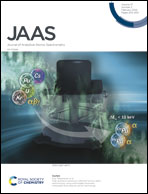Study on spark discharge enhanced laser-induced breakdown spectroscopy of Fe particles in transformer oil
Abstract
This study demonstrates the enhancement effect of spark discharge on laser-induced breakdown spectroscopy detection of Fe particles in transformer oil. To obtain a better discharge enhancement effect and improve the quantitative analysis ability, the discharge characteristics of a circuit with different parameters and the corresponding spectral enhancement effect were studied. The results show that the discharge lag time increases with the increase of capacitance, the increase of the electrode gap and the decrease of discharge capacity. At the same time, the increase of capacitance and its charging quantity leads to the increase of the discharge power in the discharge half cycle. The circuit with a 6 mm electrode gap, 8.7 nF capacitor and 500 ns 3 pulse charging ensures that the plasma has good stability and the enhanced background spectrum does not interfere with the analysis lines, increasing the limit of quantitation from 0.048 μg g−1 to 0.016 μg g−1. This work is beneficial to understand the synergistic relationship between discharge characteristics and laser ablated plasma enhancement, and promotes the application of laser-induced breakdown spectroscopy technology in the detection of particulate matter in oil.



 Please wait while we load your content...
Please wait while we load your content...